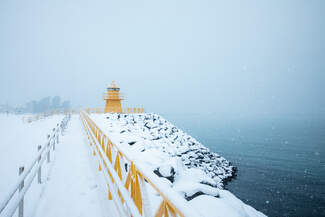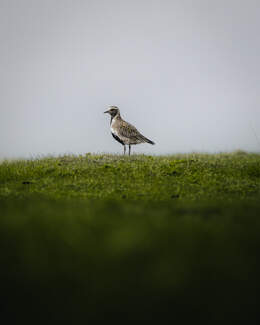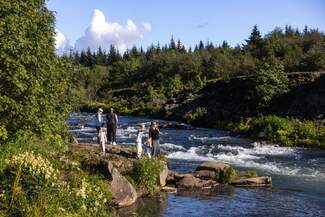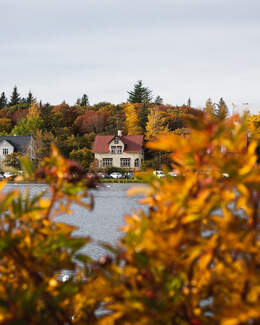
A Seasonal Guide to the Best Times of Year to Visit Reykjavík
Planning a trip to Reykjavík is an exciting venture filled with the promise of stunning landscapes, unique cultural experiences, and, of course, the mesmerising natural phenomena Iceland is famous for. However, choosing the best time to visit Reykjavík can be challenging, as each season offers its distinct charm. Whether you’re drawn by the allure of the northern lights in winter or the midnight sun in summer, this seasonal guide will help you determine the best time to visit Reykjavík based on the activities, weather, and events that align with your perfect Icelandic adventure.
Winter: The Magic of the Aurora Borealis
Winter in Reykjavík is a time of ethereal beauty, with the city often blanketed in snow and the nights lit up by the spectacular Aurora Borealis. For those eager to see the northern lights, winter is the ideal time to visit. The long, dark nights provide the perfect backdrop for this natural light show, which is visible on clear nights when solar activity is high. While the exact timing of the northern lights is unpredictable, planning your trip between October and March gives you the best chance to catch this breathtaking phenomenon.
Aside from the northern lights, winter is also an excellent time for exploring Iceland’s frozen wonders. The frozen waterfalls, such as Gullfoss and Skógafoss, are particularly stunning in the winter, their icy cascades offering a different kind of beauty compared to the summer months. Whale watching is also possible, though less common in the colder months. Reykjavík’s harbour offers tours that might allow you to spot whales, dolphins and sea birds in the chilly North Atlantic waters.
The weather in Reykjavík during winter is cold but surprisingly mild compared to other places at similar latitudes, thanks to the Gulf Stream. Average temperatures hover around 0°C (32°F), but the wind can make it feel much colder. If you don’t mind bundling up, winter offers the chance to experience Reykjavík with the soft light of winter, cosy cafes, and the festive atmosphere of Christmas and New Year’s celebrations.

Spring: The Season of Renewal
Spring in Reykjavík is a time of growth as the days gradually lengthen and the snow begins to melt, revealing the green landscapes beneath. March is still an excellent time to see the northern lights, especially early in the month, but as the season progresses, the focus shifts to other activities.
One of the highlights of visiting Reykjavík in spring is the return of wildlife. The whale-watching season kicks off in full force in April, with numerous species, including minke whales, humpback whales, and dolphins, frequenting the waters around Reykjavík. Tours from the Old Harbor provide an excellent opportunity to see these majestic creatures in their natural habitat.
Spring also brings milder weather, with average temperatures ranging from 1°C to 10°C (34°F to 50°F). While you can expect some rain, the weather is generally more stable than in winter, making it a pleasant time for outdoor activities. This season is ideal for exploring Reykjavík’s nearby attractions, such as the Golden Circle, with its geysers, waterfalls, and the Þingvellir National Park, where you can witness the dramatic tectonic rift between the North American and Eurasian plates.
As spring progresses, the landscape bursts into bloom, and you can enjoy the sight of Iceland’s wildflowers and greenery beginning to come to life.

Summer: The Land of the Midnight Sun
Summer is perhaps the most popular time to visit Reykjavík, and for good reason. From June to August, the city experiences the midnight sun, a natural phenomenon where the sun barely sets, providing nearly 24 hours of daylight. This extended daylight opens up a world of possibilities for exploration, allowing you to pack more into your days without worrying about nightfall.
Summer is the prime time for outdoor activities in Reykjavík and its surrounding areas. Hiking, biking, and horseback riding are popular, and the mild temperatures, ranging from 10°C to 15°C (50°F to 59°F), make it comfortable to spend long hours outside. This is also the best time to explore Iceland’s stunning landscapes, including its dramatic coastline, volcanic areas, and geothermal pools. Just outside Reykjavík, the Blue Lagoon is a must-visit, where you can soak in the warm, mineral-rich waters surrounded by a surreal lava field.
Whale watching continues to be a highlight in summer, with daily tours offering nearly guaranteed sightings. Birdwatching is another popular activity, particularly at locations like Puffin Island, where you can see these charming seabirds nesting.

Autumn: A Tranquil Retreat
Autumn in Reykjavík is a quieter time with a more tranquil atmosphere. The fall foliage paints the landscapes in shades of red, orange, and yellow, making this a beautiful time for photography and scenic drives.
September still offers a good chance to enjoy the last of the midnight sun while also marking the beginning of the northern lights season. As the nights grow longer, your chances of seeing the Aurora Borealis increase, particularly from mid-September onwards.
Autumn temperatures are cool, typically ranging from 3°C to 10°C (37°F to 50°F), and while rain is more frequent, it adds a fresh, crisp quality to the air. This season is ideal for those looking to experience Reykjavík at a more relaxed pace, with opportunities for indoor activities like visiting the city’s many museums, soaking in hot springs, or enjoying the local culinary scene, which often features fresh, seasonal ingredients.
Autumn is also a great time for whale watching. Although the peak season ends in October, you can still catch sight of these magnificent creatures before they migrate. Additionally, the Reykjavík International Film Festival in late September to early October is a cultural highlight, offering a chance to see new films and attend various events across the city.
Reykjavík is a year-round destination that offers something special in every season, whether you’re drawn by the northern lights, the midnight sun, or the opportunity to explore Iceland’s rugged beauty. Winter is perfect for those seeking the magic of the Aurora Borealis and serene snowy landscapes. Spring offers a time of renewal, with wildlife returning and landscapes thawing. With its endless daylight and festive atmosphere, summer is ideal for outdoor adventures and experiencing Reykjavík’s vibrant culture. With its tranquil beauty and Northern Lights, Autumn provides a peaceful retreat with the added bonus of fewer tourists.
No matter when you choose to visit, Reykjavík promises an unforgettable experience filled with natural wonders, unique activities, and the warm hospitality of Icelanders. By considering what each season has to offer, you can plan the perfect trip to Reykjavík.